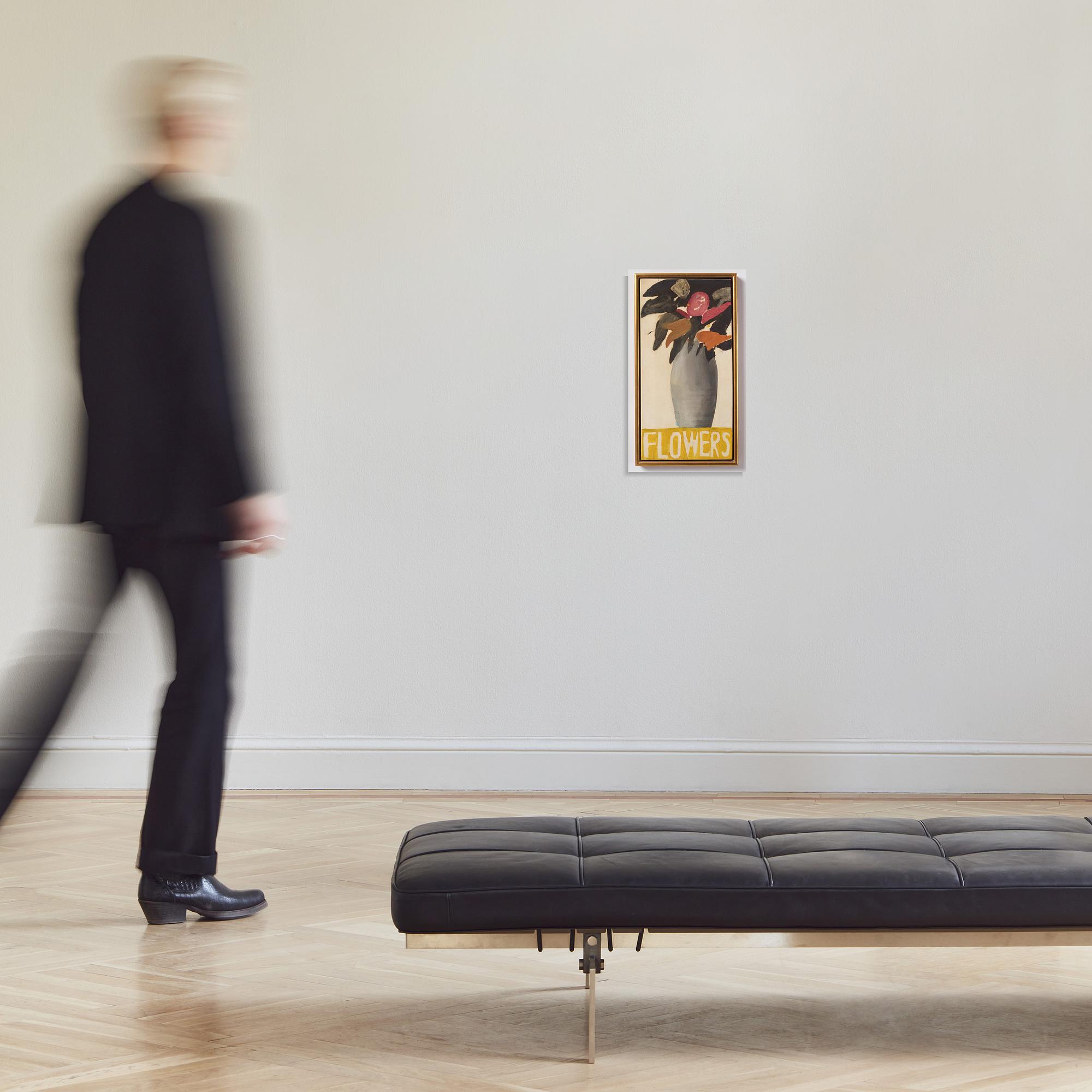David Hockney
'Flowers for a Wedding'
Signed David Hockney and dated 1962 verso. Oil on canvas 61.7 x 31.2 cm.
Alkuperä - Provenienssi
Gift from the artist to Ann Upton (later Graves), London.
Björn Bengtsson Gallery, Sweden. Acquired from the above in 1987.
Private Collection, Sweden. Acquired from the above in 1987.
Kirjallisuus
David Hockney, 'Hockney's Pictures', London: Thames & Hudson, 2007, illustrated p. 34.
Muut tiedot
‘I draw flowers every day and send them to my friends so they get fresh blooms every morning.’ – David Hockney
The still life ‘Flowers for a Wedding’, up for sale in this auction, was painted in 1962, the year David Hockney graduated from the Royal College of Art in London. The still life beautifully demonstrates how Hockney combines his admiration for modern Masters as Paul Cezanne, Henri Matisse, and Vincent Van Gogh with his unique sensibility for form, colour, and space. Against a monochrome background a large vase towers, filled with red and orange flowers and near-black leaves. The motif is cropped at the upper margin, like a snapshot, adding a sense of originality to the traditional subject. This is enhanced by the fact that the vase seems to balance atop a yellow sign with the lettering ‘FLOWERS’.
Written messages played an important part in Hockney’s work in the 60s. The artist has described how he was hesitant to use figures in his motifs as figure painting was considered very anti-modern. The solution was to add the element of enhanced typography and include written words in his work. Sometimes the lettering appears only as a title as in the painting ‘Berlin: a souvenir’ with the word BERLIN in capitals across the top. On occasion the lettering takes on a meaning, adding a cryptic message as ‘I will love you at 8 pm next Wednesday’ in ‘The Fourth Love Painting’ from 1961.
Since the 1960s, flowers are central theme of Hockney’s work. In paintings such as Domestic Scene Notting Hill, 1963, the iconic ‘Henry Geldzahler and Christopher Scott’, 1969, and ‘Model with Unfinished Self Portrait’ from 1977 the vase of flowers appears as an accent and a punctuation mark. Hockney’s depictions of flowers bear witness to the development of his unique style, his excitement regarding new printing techniques, and his endless experimentation with colour, form, and line. From paintings and etchings to lithographs and iPad drawings, the humble vase of flowers has been included and under constant review by the artist.
Hockney's friends Ann Upton and David Graves.
Hockney had met Ann Upton, in 1960 during his days at the Royal College of Art. She had sat for him on numerous occasions and by 1962 was a close friend and model, featuring in many of his drawings and paintings. David Graves was a sculptor, paper restorer and trained architect with a studio opposite Hockney’s in London. He became Hockney’s studio assistant in the 1970s. Graves accompanied Hockney on his return to Los Angeles in the late 1970s and would become closely involved in his work as well as featuring in it. Hockney would later photograph the couple’s wedding, giving rise to the monumental triptych 'The Wedding of David and Ann in Hawaii 20 May 1983'. Ann passed away in 2017 and David in 2019.
David Hockney
David Hockney was still a student at the Royal College of Art (RCA) in London when his work began to attract notice in 1962. For two years in a row Hockney’s work had featured in the Young Contemporaries at the RBA Galleries in London. The 25-year-old with the bleached mop of hair and huge horn-rimmed glasses had stirred up the art scene in the London Swinging Sixties.
For his graduation Hockney had refused to paint a female model from life as was required by the Royal College of Art. Instead, he rounded the rules and copied a muscleman out of a magazine. To prove that he mastered anatomy drawing he stuck one of his early studies of a skeleton on to it. Across the top he added the painted typography ‘Physique’ referring to the magazine name Physique Pictorial. Hockney was enjoying a new wave of confidence, and despite fighting the standard he was awarded a Gold Medal distinction from the RCA. He received it wearing an ostentatious gold lamé jacket to the ceremony.
It was at this time, he felt, 'I became aware as an artist.' That summer, in an article for Ark, the RCA journal, Dick Smith remarked, 'Hockney as a personality is bound up with his paintings. The paintings serve as letters, or diary jottings or mementoes; the figures are portraits; events portrayed did happen; someone did dance the cha-cha at three in the morning. A curtain of fantasy is drawn between the spectator and the painter, but the curtain is part of the structure which is as essential as Bardot’s towel.'
Hockney has occupied himself with the fundamentals of picture-making and of how we see the world. ‘He has delved deep into the history of art, both Eastern and Western, and frequently used the newest technology as it has become available. He has absorbed and reflected on the picture-making traditions of many times and places, which is one of the reasons why Hockney himself is a figure of global importance.’ (Martin Gayford, Tate)
























































